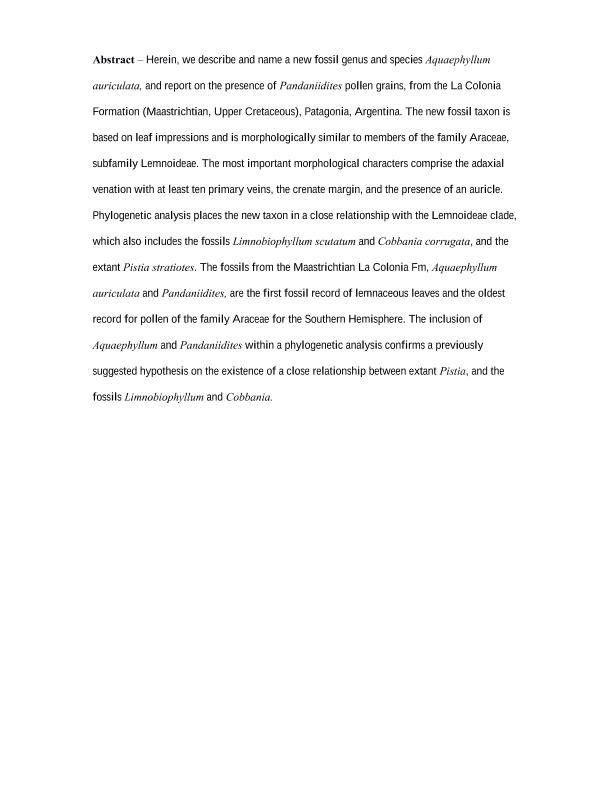Mostrar el registro sencillo del ítem
dc.contributor.author
Gallego, Julieta

dc.contributor.author
Gandolfo, María A.
dc.contributor.author
Cúneo, Néstor Rubén

dc.contributor.author
Zamaloa, María del Carmen

dc.date.available
2018-02-15T13:58:21Z
dc.date.issued
2014-12
dc.identifier.citation
Gallego, Julieta; Gandolfo, María A.; Cúneo, Néstor Rubén; Zamaloa, María del Carmen; Fossil Araceae from the Upper Cretaceous of Patagonia, Argentina, with implications on the origin of free-floating aquatic aroids; Elsevier Science; Review of Palaeobotany and Palynology; 211; 12-2014; 78-86
dc.identifier.issn
0034-6667
dc.identifier.uri
http://hdl.handle.net/11336/36506
dc.description.abstract
Herein, we describe and name a new fossil genus and species, Aquaephyllum auriculatum, and report on the presence of Pandaniidites pollen grains from La Colonia Formation (Maastrichtian, Upper Cretaceous), Patagonia, Argentina. The new fossil taxon is based on leaf impressions and is morphologically similar to members of the family Araceae, subfamily Lemnoideae. The most important morphological characters comprise the adaxial venation with at least eight primary veins, the crenate margin, and the presence of an auricle with a floating function. Phylogenetic analysis places the new taxon in a close relationship within the subfamily Lemnoideae, which also includes the fossils Limnobiophyllum scutatum, Cobbania corrugata, and the extant Pistia stratiotes. Aquaephyllum auriculatum and Pandaniidites are the first fossil record of lemnaceous leaves and the oldest record for Pandaniidites pollen for the Southern Hemisphere respectively. The inclusion of Aquaephyllum and Pandaniidites within a phylogenetic context confirms the previously suggested hypothesis on the existence of close relationships between modern Pistia, and the fossils Limnobiophyllum and Cobbania.
dc.format
application/pdf
dc.language.iso
eng
dc.publisher
Elsevier Science

dc.rights
info:eu-repo/semantics/openAccess
dc.rights.uri
https://creativecommons.org/licenses/by-nc-sa/2.5/ar/
dc.subject
Araceae
dc.subject
Argentina
dc.subject
Fossil Leave
dc.subject
Phylogeny
dc.subject
Systematics
dc.subject
Upper Cretaceous
dc.subject.classification
Meteorología y Ciencias Atmosféricas

dc.subject.classification
Ciencias de la Tierra y relacionadas con el Medio Ambiente

dc.subject.classification
CIENCIAS NATURALES Y EXACTAS

dc.title
Fossil Araceae from the Upper Cretaceous of Patagonia, Argentina, with implications on the origin of free-floating aquatic aroids
dc.type
info:eu-repo/semantics/article
dc.type
info:ar-repo/semantics/artículo
dc.type
info:eu-repo/semantics/publishedVersion
dc.date.updated
2018-02-14T19:31:29Z
dc.journal.volume
211
dc.journal.pagination
78-86
dc.journal.pais
Países Bajos

dc.journal.ciudad
Amsterdam
dc.description.fil
Fil: Gallego, Julieta. Cornell University; Estados Unidos. Museo Paleontológico Egidio Feruglio; Argentina. Agencia Nacional de Promoción Científica y Tecnológica; Argentina
dc.description.fil
Fil: Gandolfo, María A.. Cornell University; Estados Unidos
dc.description.fil
Fil: Cúneo, Néstor Rubén. Consejo Nacional de Investigaciones Científicas y Técnicas; Argentina. Museo Paleontológico Egidio Feruglio; Argentina
dc.description.fil
Fil: Zamaloa, María del Carmen. Consejo Nacional de Investigaciones Científicas y Técnicas; Argentina. Universidad de Buenos Aires. Facultad de Ciencias Exactas y Naturales. Departamento de Ecología, Genética y Evolución; Argentina
dc.journal.title
Review of Palaeobotany and Palynology

dc.relation.alternativeid
info:eu-repo/semantics/altIdentifier/doi/http://dx.doi.org/10.1016/j.revpalbo.2014.08.017
dc.relation.alternativeid
info:eu-repo/semantics/altIdentifier/url/https://www.sciencedirect.com/science/article/pii/S0034666714001286
Archivos asociados
